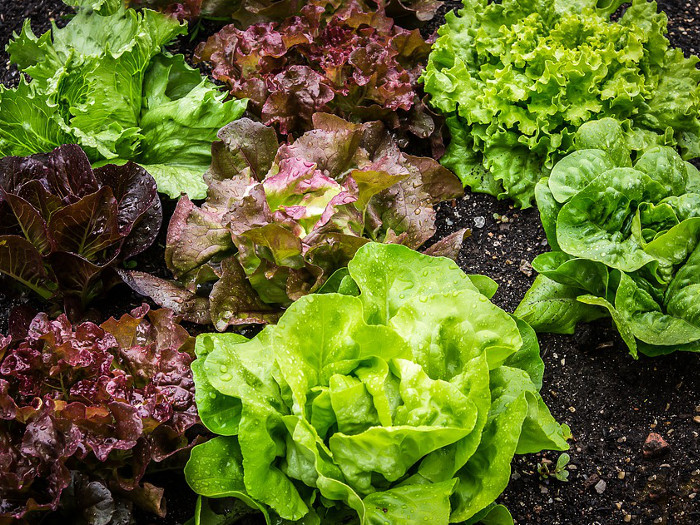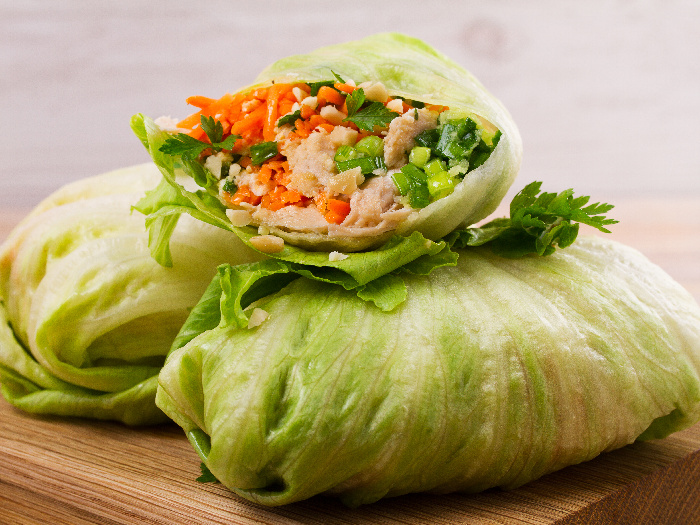Do your salad and sandwiches always contain the same old iceberg lettuce? If your culinary vocabulary is restricted to just a few varieties, then let us tell you that there’s a whole world of lettuces out there that you’ve not even explored. Right from arugula to watercress – the different types of lettuce that fill aisles of grocery stores and farmer’s markets – come in varied textures, colors, and flavors. So if you’re willing to explore the vast world of lettuces, take a look at the extensive list we’ve drawn out for you.
Different Types Of Lettuce
Let’s look at the most popular types of lettuce that will help you meet your salad requirements.
Arugula
Other names: rocket
Known for its peppery flavor, arugula has leaves that are dark green in color and are long and spiked. The leaves can also be shorter and more rounded. They are known for their pungency that makes them an acquired taste. They don’t wilt easily and keep longer in the fridge. Arugula goes perfectly well with tangy dressings like lemon garlic vinaigrette or strong flavors like blue cheese.
Best used in salads, wilted into pasta, added to burgers, on pizzas, or as a garnish over dishes.
Belgian Endive
Other names or varieties: French endive, Belgium chicory, witloof, witloof chicory.
Full of flavor and crunch, Belgian endives are tight, compact heads of lettuce that have a bit of a bitter taste. They should be used sparingly with other salad greens. It is because of this that most people prefer to braise it to caramelized perfection before adding it to their salad or dishes. Belgian endive usually has an oval shape and a soft, satiny texture. [1]
Best eaten whole or sliced in salads, or served on a crudité platter with a dip.

Mixing different types of lettuce will improve the color & texture of your salads. Photo Credit: Shutterstock
Butterhead Lettuce
Other names or varieties: Boston, bibb (limestone), mignonette, butter lettuce
Butterhead lettuce is tender in texture and large in shape, with leaves growing from a compact head. Its leaves are cupped and work well with a light flavored dressing such as honey mustard or lemon vinaigrette.
Best used in burgers or as lettuce wraps.
Batavia Lettuce
Other names: French crisp or summer crisp
Unlike most other salad greens, Batavia lettuce is more acclimatized to warmer weather. It is sweet and crunchy and stays crisp. Their jagged ruffled surfaces can add texture to salads. Batavia comes with green or red-tinted leaves and goes well when paired with honey mustard vinaigrette or balsamic dressing.
Best used in salads, as lettuce wraps or puréed into a soup.
Chrysanthemum Greens
Other names: chop suey green, crown daisy, and Japanese-green.
Chrysanthemum greens are tender and known for their peppery taste. The younger the leaves, the better they taste. Larger, and older greens have a bitter taste, which can be balanced by cooking.
Widely used in Korean, Chinese, and Japanese dishes to flavor hot pots, soups, stews, and stir-fries.
Dandelion Greens
Other names: Swedish mums
Dandelion greens have an intensely sharp, bitter taste, that can be balanced out by either braising or blanching them. They are an acquired taste, but they offer a strong flavor to the food and go well with vinegary dressings.
Best used to make tea, in salads, stews, and soups.
Frisée
Other names: chicory endive, curly chicory, curly endive
Usually, in yellow and green hues, frisée lettuces have curled leaves that are bitter to taste. They have a crunchy stem but their curly and ruffled surfaces add texture to salads. This lettuce is used as the base for the classic French bistro, which pairs well with poached eggs and bacon.
Best used in salads in raw form or wilted and sautéed to use in stews.
Iceberg Lettuce
Other names/varieties: Reine de Glace, Crisphead, Igloo lettuce
Iceberg lettuce is the variety that is most commonly used in salads. They are crispy, refreshing, and have a high water content in them. For more information, you can read, 5 Incredible Benefits Of Iceberg Lettuce. [2]
Best used in salads, tacos, burgers, and sandwiches.
Little Gems Lettuce
Other names: Sucrine, Sugar cos, baby gem
Soft in texture with a hint of crunch, little gems lettuce is known for its delicate flavor that goes well with light vinaigrettes such as a ginger vinaigrette or lemon dressing. The crunchiness of its leaves complements the zinginess of radishes or the earthy grass flavor of slightly steamed and blanched asparagus.
Best used in salads and sandwiches.
Mâche
Other names: fetticus, feldsalat, nut lettuce, field salad, corn salad, common corn salad, lamb’s lettuce
Mâche comes in the form of pretty little rosettes of dark green leaves attached in clusters around the root. They need to be cleaned thoroughly as they tend to have sand accumulated around the roots. They have a mild and sweet taste. They are usually mixed with other vegetables to make a salad as the leaves are too small and delicate to form the base. Try it with a shallot vinaigrette dressing.
Best used in salads, or as in omelets, soups, or rice.
Mesclun
Other names or varieties: spring mix, mixed baby lettuce
Mesclun is ideally not a particular type of lettuce but is instead a random mix of tender and delicate baby lettuce leaves. It means ‘mixed’ in Provencal. They are a mix of several lettuce varieties and may contain baby spinach or other small green leafy vegetables as well.
Best had raw as a mixed salad with a classic French vinaigrette dressing or a mix of dressings.
Mizuna
Other names: kyona, Japanese mustard greens, or spider mustard
An Asian variety of mustard greens, Mizuna has spiky and sharp dark green leaves with a contrasting delicate and soft texture. They have a peppery and pungent taste. Drizzling a bit of sesame seed or light vinaigrette dressing over it will help balance out the pungency. The Japanese mochi soup usually features mizuna greens.
Best had in soups, salads, pasta, and stir-fries.
Oakleaf Lettuce
Other names: Feuille de Chene
Oakleaf lettuce is a type of loose-leaf lettuce that comes in numerous varieties – red, bronze, green. They have compact heads like cabbage but have leaves that stay loose and attached only at the base. Smaller leaves can be eaten whole while the larger ones may need to be cut into bite-sized pieces.
Best used in salads with different dressings.

The healthiest way to eat most loose-leaf lettuces is by turning it into a wrap. Photo Credit: Shutterstock
Purslane
Other names: children’s spinach, little hogweed, money plant, jump up and kiss me, pot purslane, ma chi xian, garden purslane, and beldroega
Purslane is a form of wild green that is seen growing in the parks and meadows. They have thick and spongy leaves and have a slightly sour or salty taste, like spinach. For more on the medicinal properties of purslane, visit 10 Amazing Benefits Of Purslane.
Best eaten raw and cooked, in juices, salads, sandwiches, dips, pesto, stir-fries, quiches
Romaine
Other names: Cos lettuce
If you love Caesar salad, you’ll know what Romaine lettuce is. It has stiff large leaves and is quite crunchy thanks to its thick, bitter-tasting center rib. It pairs with both – a nice creamy sauce or a light vinaigrette dressing. For more, you can read our article 15 Incredible Benefits of Romaine Lettuce.
Best used as lettuce wraps, in salads, stir-fries, spring rolls, and wraps.
Radicchio
Other names/alternate names: red chicory, chioggia, red leaf chicory, castlefranco, red Italian chicory
Radicchio is a deep red-purple leafy vegetable that is known to have a spicy and bitter taste. However, if you saute or cook the leaves, they tend to sweeten and the color turns brown. There is another variety known as speckled radicchio, which is semi-green in color, and relatively soft and less bitter than its reddish-purple counterparts.
Best used in Italian cuisine or in different salads.
Watercress
Other names: yellowcress
Known for its peppery flavor, watercress (Nasturtium officinale) makes for a great addition to salads. The older the plant, the sharper the taste of the leaves, so it’s best to toss them with a feta vinaigrette or yogurt buttermilk dressing to tone down the pungency. For more on their health benefits, you can head over to, 10 Impressive Benefits Of Watercress.
Best used in salads served with grilled fish, meat, and eggs.
